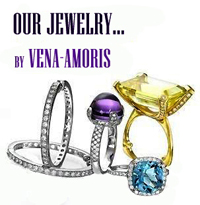[X]
Gemstones
A gemstone is the naturally occurring crystalline form of a mineral, which is desirable for its beauty, valuable in its rarity and durable enough to be enjoyed for generations.
Classification:
Gemstones can be classified into precious and semi-precious stones.
Most of the gemstones are crystals. Organic materials such as pearl, coral, amber, turtle shield are also considered gemstones.
Unlike diamonds where a quality is determined primarily by cut, in gemstones the quality is primarily determined by purity and beauty of the stone's color.
Most of the gemstones are cut and polished for usage as jewelry. The difference in cut design in diamonds and gemstones is that in diamond it is being cut to maximize its brilliance while in gemstones the stone is being cut to show the color of the stone.
Pricing gemstones is not like pricing diamonds. The last mentioned is determined according to the 4 C's. This means that the prices are fixed more or less. There is a price list for diamonds while in gemstones there is none and the prices determined according to the sellers wish.
Characteristics:
RI (Refractive index) – the measure of speed of light in a substance or medium. It is expressed as a ratio of the speed of light in vacuum relative to that in the considered medium.
Dispersion - RI of materials varies with the wavelength and frequency of light. The dispersion is what causes prisms to divide white light into its constituent spectral colors when light moves through a substance.
Specific gravity - the ratio of densities. It is measured as follow: substance volume divided by the same amount of water volume.
Hardness - a general definition: The measure of how resistant solid matter is to various kinds of permanent shape change when a force is applied. In minerals we use the mohs scale of mineral hardness. This scale is based on the ability of one natural sample of matter (mineral) to scratch another.
Cleavage - the tendency of crystalline materials to split along definite crystallographic structural planes. These planes of relative weakness are a result of the regular locations of atoms and ions in the crystal, which create smooth repeating surfaces that are visible both in the microscope and to the naked eye.
Fracture - a local separation of an object or material into two or more pieces under the action of stress. Cleavage is a specific fracture.
Luster - description of the way light interacts with the surface of a crystal. The word lustre traces its origins back to the Latin word lux, meaning "light", and generally implies radiance, gloss, or brilliance.
Treatments:
Gemstones are often treated to enhance color or clarity. Some treatments are accepted while others are not because their reached enhancements are unstable and may revert to the original state.
Heat - Heat can improve color or clarity. By heating undesired tones are removed and more desirable colors and tones are reached. The same goes for clarity – impurities are being removed for a better clarity.
Radiation - Gemstones are being irradiated to change their color into a more desirable color.
Waxing/Oiling - Gemstones like emeralds or turquoise which contain fissures are sometimes filled with colored wax or oil in order to be disguised.
Fracture filling - Inner fractures that reach the stone's surface can be filled in order to improve the stone appearance. Fracture filling in gemstones is very difficult to detect. It's usually used in diamonds and precious gemstones.


